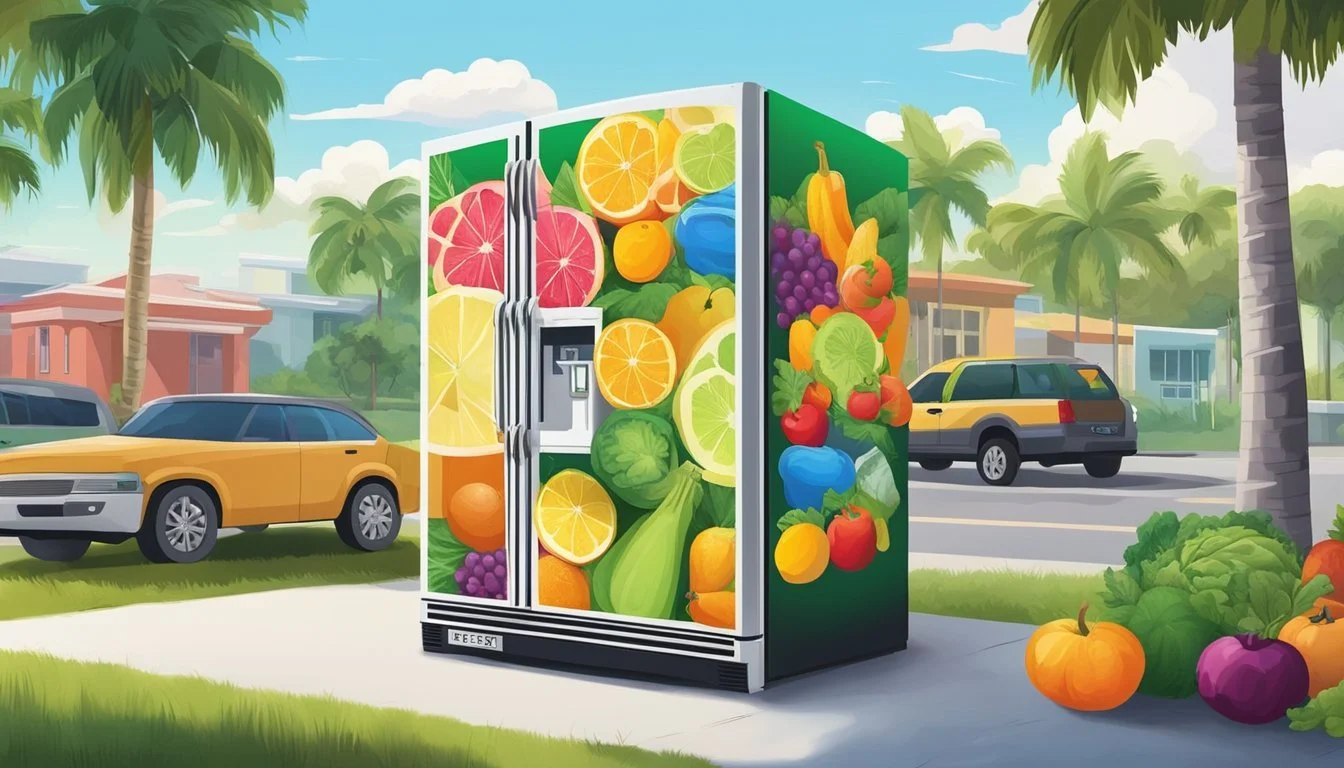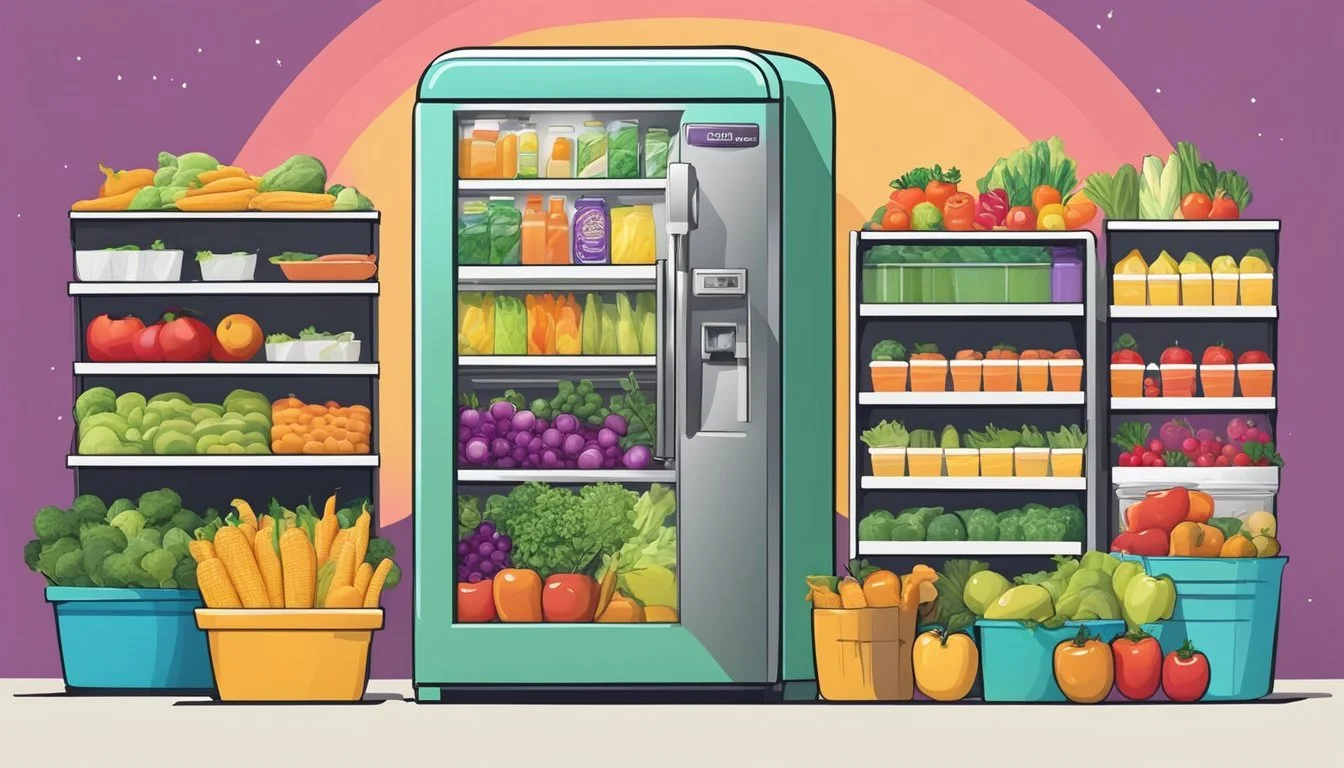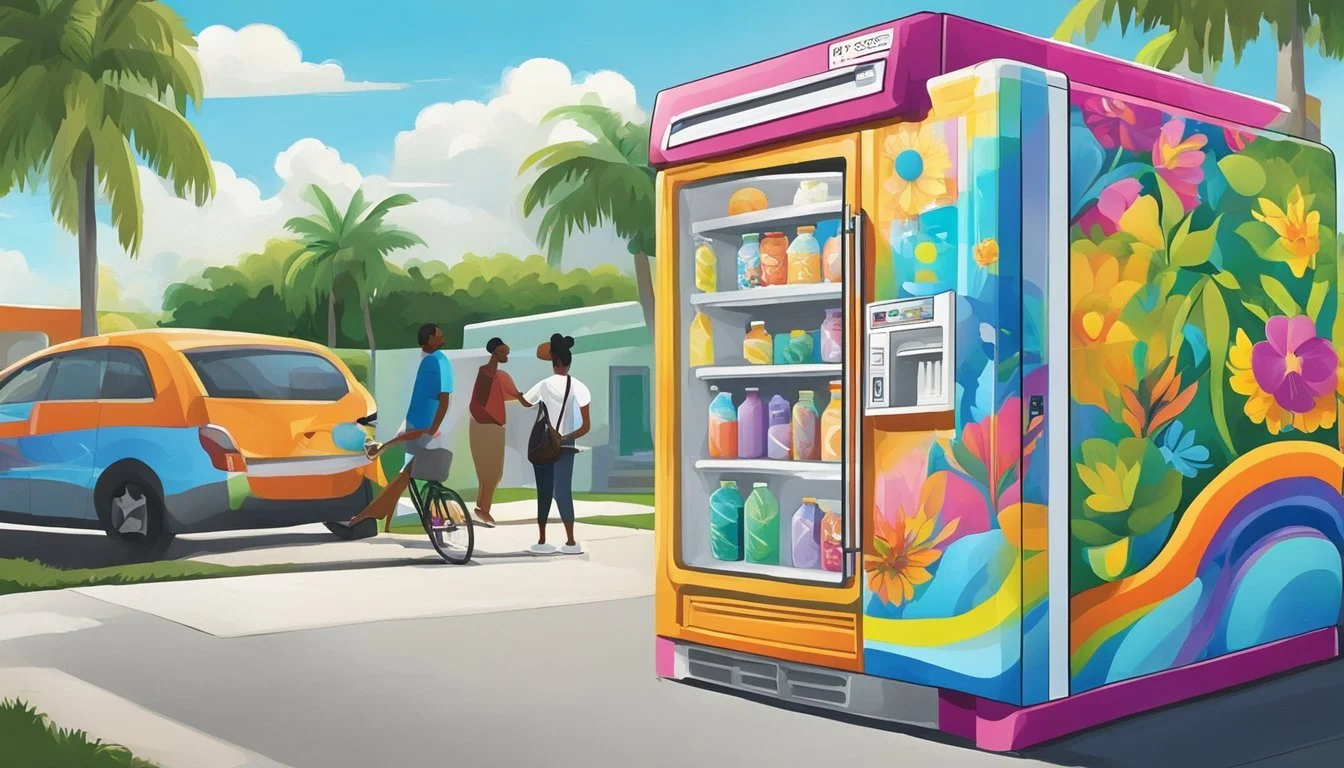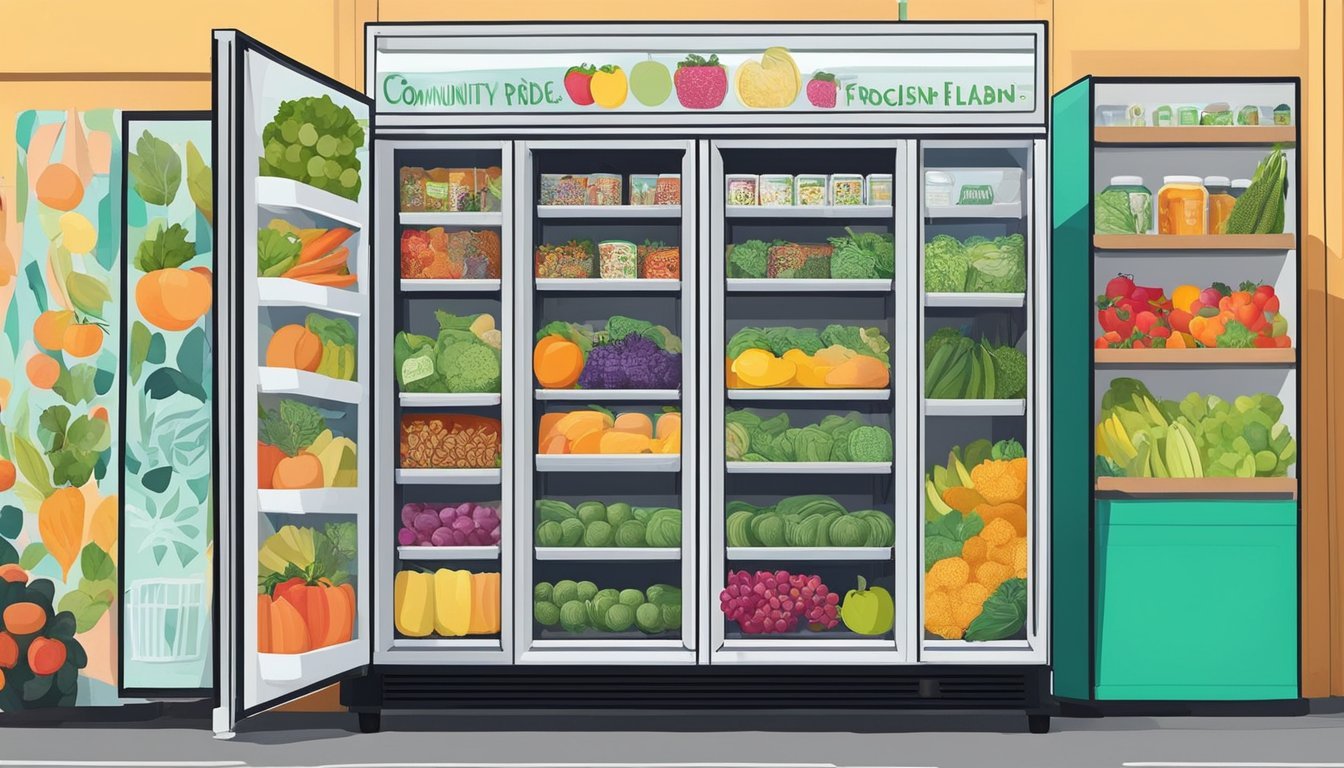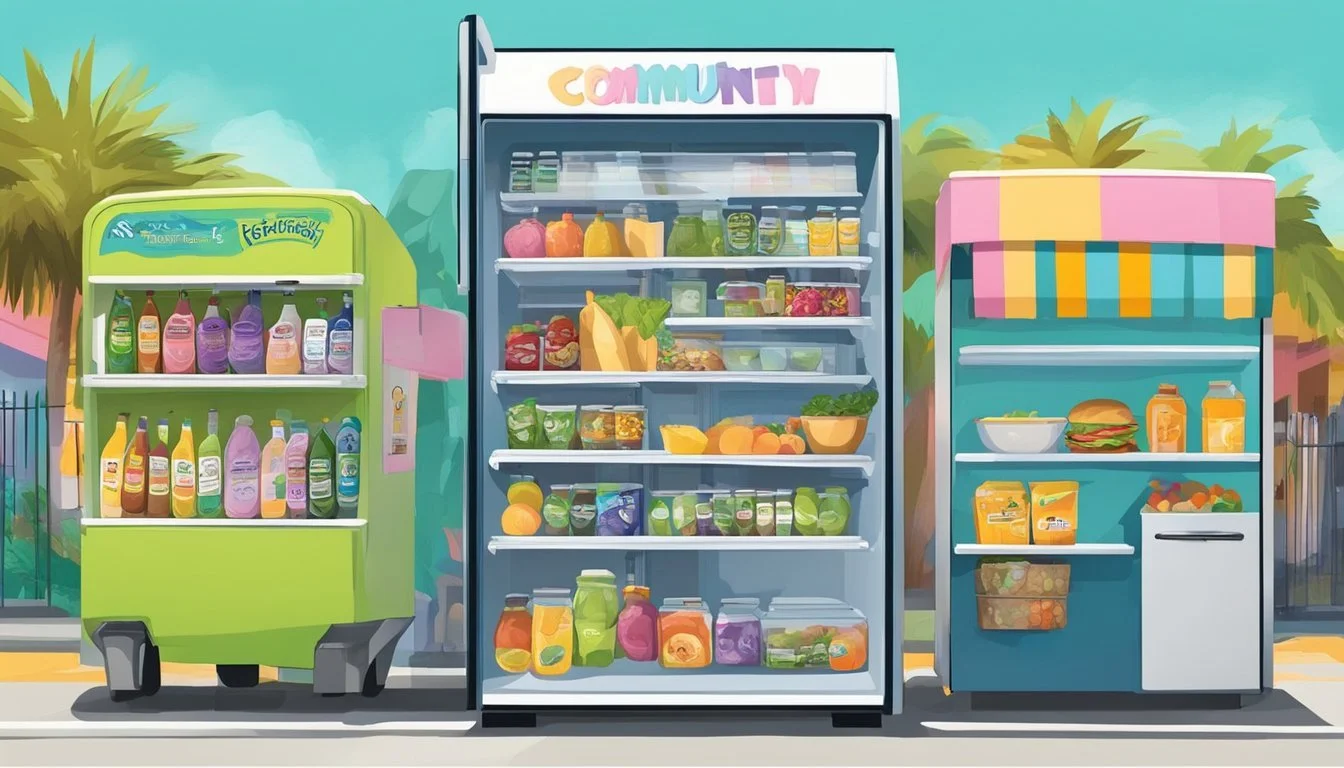Miami Gardens, FL Community Fridge
Nourishing the Local Neighborhood
In addressing the pressing issue of food insecurity, the city of Miami Gardens, Florida, has taken a proactive approach with the establishment of Community Fridges. These communal refrigerators are strategically placed throughout the city, providing access to free, nutritious food for residents who may otherwise face challenges in securing sufficient provisions. This endeavor not only alleviates hunger but also fosters a spirit of collaboration and support within the community.
The operation of the Miami Gardens Community Fridges relies on the goodwill and active participation of volunteers who dedicate time to maintain, stock, and clean these resources. Local businesses, food banks, and individual donors supplement the initiative by donating food items, ensuring a consistent supply. In this way, the fridges not only address immediate dietary needs but also encourage a communal ethos centred on sharing and caring for one another.
With a focus on nutrition, the Community Fridge initiative seeks to offer a variety of healthy food options. This is crucial in combating the larger issue of nutritional deficits often found in food deserts—areas with limited access to affordable and nutritious food options. Through this program, Miami Gardens is taking significant strides towards creating a more food-secure future for its inhabitants, embedding the ethos of collective responsibility and generosity within the fabric of the community.
Understanding Community Fridges
Community Fridges are a proactive response to food waste and hunger, providing direct food access to those in need. They operate on an open-access basis, embodying the "take what you need, leave what you can" philosophy.
What Is a Community Fridge?
A Community Fridge is a public refrigerator where individuals and businesses can leave perishable and non-perishable foods for others to freely take. It serves as a communal point where surplus food is shared, not wasted.
The Importance of Community Fridges
Community Fridges are crucial because they address two significant issues simultaneously:
Reducing Food Waste: They provide a destination for food that would otherwise go unused, turning potential waste into a valuable resource.
Alleviating Hunger: By improving food access, they offer a vital lifeline to individuals and families facing food insecurity.
How Community Fridges Work
Community Fridges function through a simple yet effective system:
Location: They are placed in easily accessible areas, often in neighborhoods where food insecurity is prevalent.
Stocking: Fridges are stocked with donations from local sources—individuals, grocery stores, restaurants, and food banks.
Maintenance: Volunteers and organizations manage the fridges to ensure they are clean and stocked.
Use: Those in need of food can take items without any requirements or restrictions.
The Miami Community Fridge Initiative
Community fridges have become an innovative approach to address food insecurity and bolster social wellness in Miami. They operate on a simple principle of mutual aid that encourages locals to 'take what you need, leave what you can'.
History and Mission
The Community Fridge Initiative in Miami was inspired by a global movement to combat food insecurity and ensure access to nutritious food within local communities. The mission is rooted in providing fresh and healthy food to those in need, particularly in areas of Miami recognized as food deserts. Volunteers and local organizations actively maintain the fridges, ensuring that the offerings are safe and wholesome for community members to consume.
Impact on Miami Gardens
Miami Gardens, one of the areas served by the initiative, has seen a tangible decrease in hunger among its residents. These community fridges have empowered residents with consistent access to fresh food, contributing greatly to the social wellness of the neighborhood. By addressing the immediate needs for nutritious meals, these fridges have become cornerstones of sustenance and solidarity in Miami Gardens.
Local Support and Collaboration
The success of the Community Fridge Initiative has been largely due to the collaboration between local businesses, non-profit organizations, and Good Samaritans. Together, they have launched and sustained a network of fridges across Miami-Dade County through donations and volunteer efforts. Partnerships with local food banks and pantries have also been crucial in stocking the fridges with surplus food, thereby reducing waste while feeding the hungry. These community fridges stand as testaments to the city's commitment to community and social wellness.
Get Involved
Engaging with the Miami Gardens Community Fridge project is an actionable way community members can tackle food insecurity. Volunteers play a fundamental role, and donations fuel the program's success, ensuring ongoing food distributions.
How to Volunteer
Individuals wishing to volunteer can contribute their time in various capacities. Volunteers are needed to maintain the fridges' cleanliness, organize food items, and ensure the fridges are stocked and operational for those in need. Interested parties should contact the coordinators of the community fridge for scheduling and volunteer opportunities.
Contact: Reach out to the fridge coordinators via email or social media.
Schedule: Sign up for available time slots that fit your schedule.
Orientation: Attend a short training session to understand the guidelines.
Organizing Food Distributions
Food distributions require planning and coordination. Food Bank partners, such as Feeding America, often support these efforts with provisions. Organizers must ensure:
Food Safety: Proper handling and storage of perishable items.
Logistics: Coherent flow during distribution events to avoid congestion.
Coordinate with local food banks for supply.
Plan the layout and timing of distributions.
Mobilize volunteers for event days.
Donation Guidelines
Donations are crucial for the sustenance of community fridges. The project adheres to a policy of accepting fresh, healthy food to support under-resourced individuals. When donating:
Accepted Items: Non-perishable goods, fresh produce, sealed packages.
Condition: Items must be within their 'use by' dates and in good condition.
Drop-off: Leave donations in designated areas of the fridge for organizers to sort.
Do's Don'ts Bring fresh fruits and veggies Donate expired or open items Provide non-perishable items Leave hot, prepared meals Check the 'use by' dates Deposit items that require special storage
By getting involved through volunteering, organizing food distributions, or making mindful donations, each community member can make a significant impact on the effectiveness of the Miami Gardens Community Fridge initiative.
Community Support Networks
In Miami Gardens, FL, community fridges serve as a nexus for support, providing essential resources to those in need. These fridges are a testament to the community's resolve and willingness to help fellow residents, fostering a collaborative spirit in the battle against food insecurity.
Buddy System Mia
Buddy System Mia has been instrumental in establishing Community Fridges across Miami-Dade County. They have positioned refrigerators in accessible locations for people facing food insecurity, embodying their ethos of "take what you need, leave what you can." Integral to their approach is the participation of local residents and businesses who donate food, helping to sustain the services that these community fridges provide.
Mutual Aid and Assistance
The concept of Mutual Aid resonates strongly in Miami Gardens. It is a form of peer-to-peer support that organizes communities into cooperative networks. The foundation of mutual aid is an understanding that collaboration enhances the group's survival and enables individuals within the community to support one another, especially during times of need. Community fridges are a prime example of mutual aid in action, directly addressing food scarcity by creating a shared resource for all.
Connecting through Social Media
Social media platforms, especially Instagram, have become pivotal in connecting the Miami Gardens community to its support networks. The @miamicommunityfridge Instagram account plays a key role in spreading awareness, encouraging donations, and organizing upkeep for the fridges. By leveraging these platforms, the community fridge movement maintains transparency, fosters engagement, and mobilizes collective action toward their cause.
Sustainable Practices
In Miami Gardens, FL, the Community Fridge program is a key initiative addressing sustainability with an innovative approach to food distribution. They focus on reducing food waste while ensuring access to nutritious food options for those in need.
Reducing Food Waste
Miami Gardens' Community Fridge makes substantial strides in minimizing food waste by allowing residents to "take what you need, leave what you can." This system encourages the sharing of excess perishable food, which might otherwise go to waste. A critical component of this practice is the effective management of these resources to ensure food safety and minimize spoilage while promoting sustainability.
Key Actions:
Providing a platform for excess food distribution
Ensuring food safety and minimizing spoilage
Promoting Healthy Food Options
The Community Fridge initiative actively promotes healthy eating habits by stocking the refrigerators with a variety of healthy food options. Fresh produce and nutritious perishable foods are made readily available to the community. This practice not only supports individual well-being but also contributes to the sustainable food landscape of Miami Gardens.
Available Produce:
Vegetables: Carrots, Lettuce, Tomatoes
Fruits: Apples, Oranges, Bananas
Through strategic placement and community participation, Miami Gardens' Community Fridges serve as a beacon of sustainable living and collective responsibility.
Cultural and Artistic Influence
In Miami Gardens, FL, the Community Fridge initiative is not only a fight against food insecurity but also a canvas for local culture and artistic expression.
Local Artists' Contributions
A collective of local artists, including Vic Garcia, Reyna Noriega, Ahol Sniffs Glue, Alex Yanes, and others, have transformed everyday refrigerators into vibrant works of art. These artists, through their unique styles, have infused the community fridges with visual stories that reflect the local community's spirit. For instance, Ahol Sniffs Glue, known for his distinct eye motifs, and Alex Yanes, with his whimsical, colorful, and dynamic designs, have each painted a fridge, turning a mundane object into a symbol of community pride.
The Aesthetic of Miami's Fridges
Miami's Community Fridges stand out thanks to their aesthetic appeal that includes a lively mix of colors and themes. One consistent narrative across these fridges is the representation of Miami's diverse culture and heritage.
Atomik: The artist's iconic 'Orange' character lends a playful and immediately recognizable touch to the fridges.
Alex Yanes: Yanes’ contribution is characterized by his 3D compositions that often feature geometric patterns and a bold palette.
Haiiileen: Known for her use of lights and reflective materials, Haiiileen's fridge might present a futuristic twist, speaking to Miami's position as a forward-looking city.
These artistically adorned fridges not only serve a practical purpose but have also become fixtures of local art, showcasing the city's creative pulse to all residents and visitors who encounter them.
Locations and Access
The Community Fridge initiative in Miami Gardens, FL, is a vital resource for residents facing food insecurity, offering free and healthy food options at various strategic locations, including neighborhoods with higher needs for such services.
Fridge Locations in the Community
Coconut Grove: The historic neighborhood often frequented by tourists and locals alike, has a community fridge that serves both its residents and the transient population.
Hialeah: In the heart of one of the most densely populated areas in Miami-Dade County, a fridge is available to address food scarcity issues.
Little Haiti: This vibrant community hosts a fridge to support its culturally rich yet economically challenged residents.
Richmond Heights: A suburb with a strong sense of community, Richmond Heights offers a fridge to those in need.
Overtown: With a storied past and revitalization efforts underway, Overtown's community fridge provides a necessary resource to the community.
Homestead: Situated at the southern end of Miami-Dade County, Homestead's fridge is a crucial point of support for both urban and agricultural communities.
Florida City: As the last stop before the Florida Keys, the fridge in Florida City serves a diverse population, including transient and resident communities.
Access for Elderly and Disabled
Accessibility: The fridge locations provide ground-level access, ensuring that elderly individuals or those with disabilities can reach them without facing barriers.
Assistance: Some locations have volunteers available to assist those who may need help with reaching or carrying items from the fridges.
Each fridge location is chosen to maximize convenience and ease of access for all community members, with a focus on serving as many people as possible while addressing the unique needs of each neighborhood.
Food and Nutrition
Community fridges in Miami Gardens, FL, offer a way to tackle food insecurity by providing a diverse range of food to those in need. Residents have access to fresh, nutritious food options that support a balanced diet, ensuring their nutritional needs are met.
Types of Food Available
The community fridge in Miami Gardens is stocked with an assortment of essential food items. These include:
Fruits: Apples, oranges, and bananas.
Vegetables: Leafy greens such as spinach and vegetables like carrots and tomatoes.
Meat: Chicken and occasionally beef, when available.
Eggs: Often included as a protein-rich option.
Bread: Whole wheat and multigrain varieties for fiber intake.
Meals: Prepared meals that are ready to eat, helpful for those without cooking facilities.
These food items represent a sample of what may be found in the community fridge; availability can vary based on donations.
Maintaining Nutritional Value
To ensure the nutritional value of food is maintained:
Temperature Control: The fridge is kept at a consistent temperature to preserve freshness and prevent spoilage, especially for perishable goods like meat and dairy.
Stock Rotation: Volunteers regularly check and rotate stock to make sure older items are used first and to minimize waste.
Education: Information on nutrition is often provided alongside food items to educate the community on maintaining a balanced diet.
Fresh produce and protein sources are prioritized to supply the necessary vitamins, minerals, and amino acids essential for health. The community fridge initiative strives not just to feed but to nourish its community.
Challenges and Solutions
The Community Fridge initiative in Miami Gardens tackles critical issues such as food scarcity in low-income areas, maintaining food safety and community trust, and mitigating impacts from the COVID-19 pandemic. These fridges represent not just a source of nourishment, but also a symbol of mutual aid and resilience in the face of adversity.
Addressing Food Deserts
Miami Gardens has employed the Community Fridge project as a direct response to the phenomenon of food deserts—urban areas where residents have little to no access to fresh and affordable groceries. Nonprofits have strategically placed fridges within these neighborhoods, ensuring that the residents can obtain fresh produce and other food items. This solution helps bridge the gap where traditional grocery stores are absent.
Security and Honor System
A major challenge for community fridges is the maintenance of food safety and the adherence to the honor system—ensuring that individuals take only what they need and contribute when they can. Measures taken include:
Regular monitoring and restocking of fridges by volunteers.
Clear posting of guidelines on fridge use for the community.
Installation of cameras as a deterrent against potential misuse.
These steps, while not foolproof, help maintain the integrity of the community fridge system.
Impact of COVID-19
The COVID-19 pandemic has intensified food insecurity issues. The Community Fridge initiative adapted by implementing additional health and safety protocols to reduce virus transmission risks, such as:
Regular sanitization of the fridge handles and surfaces.
Encouraging social distancing by marking the ground near fridges to manage queues.
Mask mandates during food collection and donation activities.
These actions have been vital for the initiative's continuance throughout the pandemic, allowing it to provide uninterrupted assistance to those in need.
Local Heroes and Inspirations
The success of the Miami Gardens Community Fridge initiative is a tapestry woven by influential individuals and dedicated community organizations. These local heroes and inspirations are emblematic of compassionate action that tackles food insecurity, turning empty spaces into hubs of nourishment and hope.
Influential Individuals
Kristin Guerin: Kristin Guerin, a Miami native and a cornerstone of the Community Fridge Project, has harnessed the power of art and activism to combat hunger. She combines her creative talents with compassionate outreach, ensuring that the fridges are not only a source of free food but also a canvas that celebrates local culture.
Vic Garcia: Garcia, a steadfast volunteer, dedicates his time to the maintenance and stocking of these public refrigerators. His role is crucial in keeping the fridges operational, safe, and accessible to all that rely on them.
Community Organizations
Roots Collective: This local group has emerged as a central figure in the Miami Community Fridge movement. By collaborating with civic-minded entities, they maximize the impact of the fridges, transforming them into community landmarks.
Public Refrigerators: Various anonymous community members contribute to the fridge's upkeep with regular cleaning and restocking efforts, solidifying the fridge's status as a reliable resource for residents in need. Their silent but essential work underscores the collaborative spirit powering the project.
Dance and Other Arts: Integrating the arts into social initiatives, local dance groups and artists have performed and created, drawing attention to the fridges and further encouraging community engagement and donation drives. Through dance and expressive art, they have turned the act of giving into a communal celebration.
Future of Community Fridges
The trajectory of community fridge initiatives in Miami Gardens indicates an optimistic expansion and deepening of their roles in local food security efforts.
Expansion Plans
The Community Fridge Network in Miami Gardens is focusing on adding new locations to ensure broader accessibility to free food for individuals experiencing food insecurity. They have identified strategic areas that are currently underserved and are actively seeking support through various means, including fundraisers and GoFundMe campaigns, to implement more fridges. Each new fridge location will be selected based on community needs assessments and available resources.
Continuing the Mission
As these community fridges become a staple feature in Miami Gardens, the mission continues to not only provide free food but also to educate and engage the community. The organizers are committed to maintaining the fridges and supplying them with nutritious food options. Sustainability of this endeavor is key, and the network is always looking for volunteers and local businesses that are willing to partner and support the cause through donations and collaborative events.

